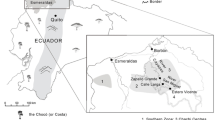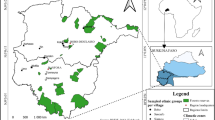Abstract
We used palm knowledge to understand the interaction between people and the rainforests and the factors that influence this dynamic process. We interviewed 278 informants in 12 villages in the Pastaza and Madidi areas of the western Amazon basin. Together they used 38 different palm species for 38 different uses in six use-categories (food, construction, utensils, ritual, medicine, commercial). Euterpe precatoria, Iriartea deltoidea, and Oenocarpus bataua were best known and were mentioned as useful by 76–72% of the informants in the 12 villages. There was a great variation in number of uses and in how widespread the uses were and five of the 38 useful palms were mentioned by only one informant. Among the socioeconomic factors analyzed, the residence village influenced the informants’ knowledge of palms and their uses more than any other factor. Length of education, prosperity and for how long the informant had lived in the village were also positively correlated to how many palms and palm uses were known. Gender differences in informants’ knowledge of palm uses were not observed in our data. We suggest, that the high importance of forest products to the livelihood of the villagers, the great variation in the knowledge they possess, and the fact that the differences between villages is so great, are important elements to consider when developing management plans for the sustainable use of the rainforest resources in the western Amazon.
Similar content being viewed by others
References
Anderson AB (1991) Forest management strategies by rural inhabitants in the Amazon estuary. In: Goméz-Pompa A, Whitmore TC, Hadley M (eds) Rain forest regeneration and management. United Nations Educational, Scientific and Cultural Organizations, Paris, France, pp 351–360
Anyinam C (1995) Ecology and ethnomedicine: exploring links between current environmental crisis and indigenous medical practices. Social Sci Med 40:321–329
Arnold JEM, Ruiz Pérez M (2001) Can non-timber forest products match tropical forest conservation and development objectives? Ecol Econ 39:437–447
Atran S, Medin D, Ross N, Lynch E, Vapnarsky V, Ucan Ek E, Coley J, Timura C, Baran M (2002) Folkecology, cultural epidemiology and the spirit of the commons. Curr Anthropol 43:421–450
Balick MJ (1984) Ethnobotany of palms in the Neotropics. Adv Econ Bot 1:9–23
Balslev H, Barfod A (1987) Ecuadorean palms—an overview. Oper Bot 92:17–35
Barham BL, Coomes OT, Takasaki Y (1999) Rain forest livelihoods: income generation, household wealth and forest use. Unasylva 198:34–42
Bates DM (1988) Utilization pools: a framework for comparing and evaluating the economic importance of palms. Adv Econ Bot 6:56–64
Begossi A (1996) Use of ecological methods in ethnobotany: diversity indices. Econ Bot 50:280–289
Belcher B, Ruíz Pérez M, Achdiawan R (2005) Global patterns and trends in the use and management of commercial NTFPs: implications for livelihoods and conservation. World Dev 33:1435–1452
Benz BF, Cevallos J, Santana F, Rosales J, Graf S (2000) Losing knowledge about plant use in the Sierra de Manantlan biosphere reserve, Mexico. Econ Bot 54:183–191
Beck S, García E, Zenteno F (2002) Flora del parque nacional y área natural de manejo integrado Madidi. CARE-Bolivia. La Paz, Bolivia, 46 pp
Boom B (1987) Ethnobotany of the Chacobo Indians, Beni, Bolivia. Adv Econ Bot 4:1–68
Boot RGA (1997) Extraction of non-timber forest products from tropical rain forests. Does diversity come at a price? Neth J Agric Sci 45:439–450
Borchsenius F, Borgtoft H, Balslev H (1998) Manual to the palms of Ecuador. AUU Rep 37:1–217
Byg A, Balslev H (2001) Diversity and use of palms in Zahamena, eastern Madagascar. Biodivers Conserv 10:951–970
Byg A, Balslev H (2004) Factors affecting local knowledge of palms in Nangaritza Valley in South-Eastern Ecuador. J Etnhnobiol 24:255–278
Campos MT, Ehringhaus C (2003) Plant virtues are in the eyes of the beholders: a comparison of known palm uses among indigenous and folk communities of southwestern Amazonia. Econ Bot 57:324–344
Coomes OT (1996) Income formation among Amazonian peasant households in Northeastern Peru: empirical observations and implications for market-oriented conservation. Yearb Conf Lat Am Geogr 22:51–64
Coomes OT (2004) Rain forest ‘conservation through use’? Chambira palm fibre extraction and handicraft production in a land-constrained community, Peruvian Amazon. Biodivers Conserv 13:351–360
Coomes OT, Barham BL (1997) Rain forest extraction and conservation in Amazonia. Geogr J 163:180–188
Coomes OT, Burt GJ (1997) Indigenous market-oriented agroforestry: dissecting local diversity in western Amazonia. Agroforest Syst 37:27–44
Escobendo A, Ríos C (2003) Uso de la fauna silvestre, peces y otros productos forestales no maderables en las comunidades de las etnias Quechua y Achuar del río Huasaga, Loreto-Abanico de Pastaza. Universidad Nacional de la Amazonía Peruana. Tesis de Licenciatura en Biología. Iquitos, Abanico de Pastaza
Figueiredo GM, Leitão-Filho HF, Begossi A (1993) Ethnobotany of Atlantic forest coastal communities: Diversity of plant uses in Gamboa (Itacuruçá Island, Brazil). Hum Ecol 21:419–430
Gadgil M, Heman NS, Reddy BM (1998) People, refugia and resilience. In: Berkes F, Folke C, Colding J (eds) Linking social and ecological systems. Cambridge University Press, pp 30–47
Gari J (2001) Biodiversity and indigenous agroecology in Amazonia: the indigenous people of Pastaza. Etnoecologica 5(7):21–37
Hall P, Bawa K (1993) Methods to assess the impact of extraction of non-timber tropical forest products on plant populations. Econ Bot 47:234–247
Hanazaki N Tamashiro JY, Leitão-Filho HF, Begossi A (2000) Diversity of plant uses in two Caiçara communities form the Atlantic forest coast, Brazil. Biodivers Conserv 9:597–615
Henderson A. (1995) Palms of the Amazon. Oxford UP, Oxford
Holmgren P, Holmgren NH, Barnett LC (eds) (1990) The Herbaria of the world. Index Herbariorum. New York Botanical Garden, New York
Johns T (1994) Ambivalence to the palatability factors in wild food plants. In: Etkin NL (ed) Eating on the wild side. Arizona University press, Tucson, pp 46–61
Ladio AH (2001) The maintenance of wild edible plant gathering in a Mapuche community of Patagonia. Econ Bot 55:243–253
Ladio A, Lozada M (2000) Edible wild plant use in a Mapuche community of nortwestern Patagonia. Hum Ecol 28:53–71
Ladio A, Lozada M (2004) Patterns of use knowledge of wild edible plants in distinct ecological environments: a case study of a Mapuche community from northwestern Patagonia. Biodivers Conserv 13:1153–1173
Lawrence A, Phillips OL, Reategui A, López M, Rose S, Wood D, José Farfan A (2005) Local values for harvested forest plants in Madre de Dios, Peru: towards a more contextualized interpretation of quantitative ethnobotanical data. Biodivers Conserv 14:45–79
Legendre P, Legendre L (1998) Numerical ecology. Developments in environmental modelling, 20, 2nd English edn. Elsevier, Ámsterdam
Luoga EJ, Witkowski ETF, Balkwill K (2000) Differential utilization and ethnobotany of trees in Kitulanghalo Forest Reserve and surrounding communal lands, eastern Tanzania. Econ Bot 54:328–343
McCune B, Grace JB (2002) Analysis of ecological communities. MjM Software, Gleneden Beach, Oregon
Moerman DE (1996) An analysis of the food plants and drug plants of native North America. J Ethnopharmacol 52:1–22
Normand S, Vormisto J, Svenning J-C, Grandez C, Balslev H (2006) Geographical and environmental controls of palm beta diversity in paleo-riverine terrace forests in Amazonian Peru. Plant Ecol 186:161–176
Ohmagari K, Berkes F (1997) Transmission of indigenous knowledge and bush skills among the Western James Bay Cree women of Subarctic Canada. Hum Ecol 25:197–222
Padoch C, de Jong W (1992) Diversity, variation, and change in Ribereño agriculture. In: Plotkin M, Famolare L (eds) Conservation of neotropical forests—working from traditional resource use. Conservation International & Island Press, Washington D.C., pp 253–262
Phillips O, Gentry AH (1993a) The useful plants of Tambopata, Peru: I. Statistical hypotheses tests with a new quantitative technique. Econ Bot 47:15–32
Phillips O, Gentry AH (1993b) The useful plants of Tambopata, Peru: II. Additional hypothesis testing in quantitative ethnobotany. Econ Bot 47:33–43
Pichon FJ (1997) Settler households and land-use patterns in the Amazon frontier: farm-level evidence from Ecuador. World Dev 25:67–91
Plotkin MJ, Balick MJ (1984) Medicinal uses of South American palms. J Ethnopharmacol 10:157–179
Poteete AR, Welch D (2004) Institutional development in the face of complexity: developing rules for managing forest resources. Human Ecol 32:279–311
Prance GT, Balée W, Boom BM, Narneiro RL (1987) Quantitative ethnobotany and the case for conservation in Amazonia. Conserv Biol 1:296–310
Ross N (2002) Lacandon Maya intergenerational change and the erosion of folk biological knowledge. In: Stepp JR, Wyndham FS, Zarger RK (eds) Ethnobiology and biocultural diversity. The International Society of Ethnobiology, pp 585–592
Steinberg MK (1999) Maize diversity and cultural change in a Maya agroecological landscape. J Ethnobiol 19:127–139
Silva R, Robinson D, McKean S, Alvarez P (2003) La historia de la ocupación del espacio y el uso de los recursos en el PNANMI Madidi y su zona de influencia. Informe para el Proyecto Apoyo a la Administración del Parque Nacional y Area Natural de Manejo Integrado Madidi. CARE-Bolivia. La Paz, Bolivia
Stagegaard J, Sørensen M, Kvist LP (2002) Estimation of the importance of plant resources extracted by inhabitants of the Peruvian Amazon flood plains. Perspect Plant Ecol Evol Syst 5:103–122
Styger E, Rakotoarimanana JEM, Rabevohitra R, Fernandes ECM (1999) Indigenous fruit trees of Madagascar: potential components of agroforestry systems to improve human nutrition and restore biological diversity. Agroforest Syst 46:289–310
Ticktin T (2004) The ecological implications of harvesting non-timber forest products. J Appl Ecol 41:11–21
Tuomisto H, Ruokolainen K, Kalliola R, Linna A, Danjoy W, Rodriguez Z (1995) Dissecting Amazonian biodiversity. Science 269:63–66
Turner NJ (1988) The importance of a rose: evaluating the cultural significance of plants in Thompson and Lillooet Interior Salish. Am Anthropol 90:272–290
Wiersum KF (1997) Indigenous exploitation and management of tropical forest resources: an evolutionary continuum in forest-people interactions. Agric Ecosyst Environ 63:1–16
Zar JH (1996) Biostatistical analysis, 3rd edn. Prentice-Hall International Inc., New Jersey, USA
Zent S (1999) The quandary of conserving ethnoecological knowledge—a Piaroa example. In: Gragson TL, Blount BG (eds) Ethnoecology—knowledge, resources, and rights. University of Georgia Press, Athens, USA, pp 90–124
Acknowledgements
Many people helped us in this study, and we thank all of them for their support. We are especially grateful to Conservation International in Rurrenabaque, the office of Madidi National Park in San Buenaventura, and FESPAI and CIPTA in Tumupasa and Ixiamas who gave much practical help with logistics and field work in Madidi, to Tina Knudsen and Ulrik Lyng who helped with the interviews in the Pastaza area, to Eladio Chao in Madidi and Antonio Ojaikate in Pastaza, who were our guides and contacts to the people we interviewed. To the inhabitants of the visited villages, who gave us their time and hospitality and patiently answered our questions, we are forever indebted. The Council for Development Research, Danida Project #104, Dan 8-764 financed the work in Perú, and Danida Project #104, Dan 8L-206 financed the work in Bolivia.
Author information
Authors and Affiliations
Corresponding author
Rights and permissions
About this article
Cite this article
Zambrana, N.Y.P., Byg, A., Svenning, JC. et al. Diversity of palm uses in the western Amazon. Biodivers Conserv 16, 2771–2787 (2007). https://doi.org/10.1007/s10531-007-9218-y
Received:
Accepted:
Published:
Issue Date:
DOI: https://doi.org/10.1007/s10531-007-9218-y




